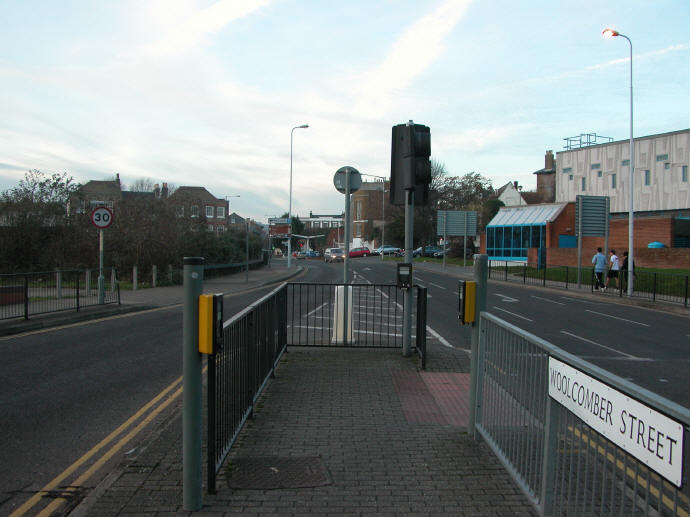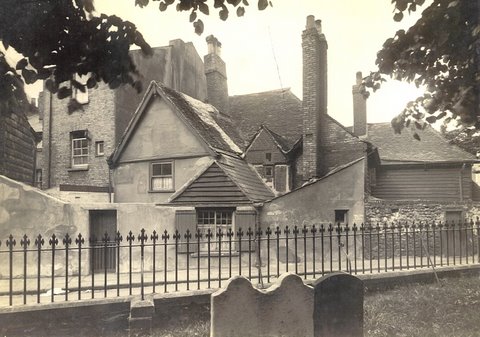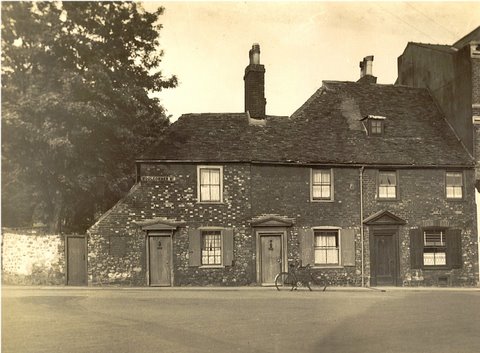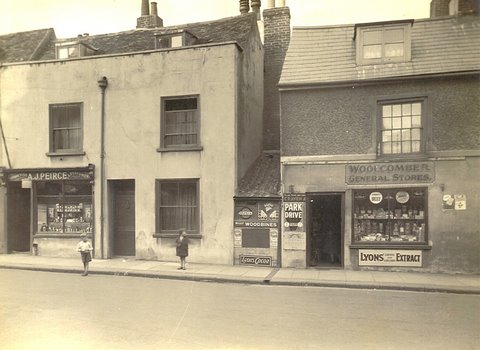| |

Woolcomber Street today, viewed from
the junction with Townwall Street, looking towards St James's Church
Woolcomber Street, connecting Eastbrook Place with Townwall Street, was once a busy
street lined with shops and houses. My great grandfather, an umbrella
maker and bath chair proprietor, had his shop on the right of the
picture at no. 13. On the left would have been the gardens of the
Burlington Hotel, which was one of the many properties in the area badly
damaged by bombs and shells during the second World War.
In my youth, I remember the area on the right at the far end of the road as St. James' churchyard - it was taken
over by the local council to make a car park when the swimming pool and leisure centre
(right foreground in the picture) was built.
"The earliest known industry, in this locality, was the making of
salt. In the depression left by the old harbour, sea water collected
at every tide, and salt being, at that time, a scarce and valuable
commodity, salt-pans were constructed here, by which sea water was
evaporated, and salt produced for domestic use. After the salt
makers, came the wool combers; and they, in turn, were succeeded by
smugglers, who had the hardihood to defy the royal Customer right under
the Castle walls, and to use caves in the cliff to hide their contraband
goods.
Woolcomber Street boasts to-day a palatial hotel, the Burlington,
which dominates the whole neighbourhood; but opposite to it is a small
hostelry, much older - the Mail Packet Inn, which is a remnant of the time
when the mail packets landed their passengers in the Bay. Between
Woolcomber Street and Trevanion Street are Trevanion Lane and Woolcomber
Lane. A peep into these will afford traces of the wool combers and
the 'Free Traders.' Here, too, was St. James's poorhouse in the 18th
century. On the east side of Woolcomber Street are some houses
marked Exhibition Place, so named because they were built in 1851, the
year of the Great Exhibition in Hyde Park. The wool combers'
dwellings stood there previously. At the bottom of Woolcomber Street
is Marine House, which, some thirty years ago, was the home of our present
Dover School of Art." (J.B.J. 1907)
|
| |

The backs of the houses in Woolcomber Street, near the
junction with St James's Street, looking South across Trevanion Street from St James's Churchyard.
"Dover Harbour, in Norman times, was under the Castle
Cliff, where Woolcomber and Trevanion Streets, with the intervening space,
including Trevanion Lane, and Woolcomber Lane, now are. These streets
are not ancient, as may be inferred from their names. The one takes
its name from some houses which were occupied by woolcombers, in the 18th
century; and the other takes its name from the Hon. John Trevanion, M.P.,
who had a residence there in the 18th century." (J.B.J.
1907)
|
| |

This view is looking North East across Woolcomber
Street near the junction with St James's Street and Trevanion Street.
"When Woolcomber and Trevanion Streets formed the site
of the harbour, a branch of the Dour, called Eastbrook, emptied itself
there. That harbour lay without the town wall, and was approached
through Eastbrook Gate, at a place called Mansfield's Corner. This
place is mentioned in the Corporation records in the reign of Charles I.,
..." (J.B.J. 1907)
|
| |
"The widening of Woolcomber Street commenced in 1855, when the old
Parsonage at its entrance was demolished, and it was continued in 1894,
when the residence of Dr. Parsons was taken down, as well as the whole of
the houses on the western side up to the grounds of the Burlington Hotel,
and the consequent rebuilding left the street as it is to-day, except that
the subsequent renovation of the big hotel has given the whole
neighbourhood a smarter appearance." (J.B.J. 1907)
|



